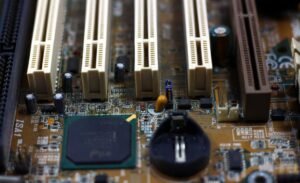Giga Factory Lens
The Giga Factory Lens is a unique lens that enables users to see inside the massive manufacturing facilities known as Giga Factories. These factories, often owned by technology companies, are responsible for the production of various electronic components, such as batteries and solar panels.
Key Takeaways:
- The Giga Factory Lens allows users to gain insight into the inner workings of Giga Factories.
- It enables a detailed view of the manufacturing processes and equipment used.
- With this lens, users can understand the scale and efficiency of Giga Factories.
**The Giga Factory Lens is a game-changer for those interested in understanding the massive manufacturing processes behind their favorite electronic products.** By providing a clear view of the inner workings of Giga Factories, this lens offers valuable insights into the scale, efficiency, and technology employed in these facilities.
Have you ever wondered how batteries or solar panels are manufactured at such a large scale? *The Giga Factory Lens provides a captivating window into these intricate operations.* Within Giga Factories, assembly lines stretch out as far as the eye can see, and workers and robots work in harmony to produce thousands of products every day.
Understanding Giga Factories
To comprehend the scale of Giga Factories, let’s take a look at some impressive numbers:
| Company | Factory Location | Factory Size |
|---|---|---|
| Tesla | Nevada, USA | 5.3 million square feet |
| Gigafactory Berlin-Brandenburg | Germany | 300,000 square meters |
*It is truly remarkable to see such massive structures dedicated solely to the production of a single product or component.* The Giga Factory Lens allows users to witness the efficient utilization of space and resources that these factories employ.
The Giga Factory Lens is also useful for gaining insights into the manufacturing processes utilized in Giga Factories. Here are some notable practices:
- *Just-in-time production*: Giga Factories adopt a lean manufacturing approach, where components and materials are delivered in sync with production needs, minimizing waste and optimizing efficiency.
- *Automation*: Robots play a significant role within these factories, performing repetitive tasks with precision and speed, ultimately improving output and reducing human error.
- *Vertical integration*: Giga Factories often aim to control the entire production process, from raw materials to finished products, reducing dependence on external suppliers and ensuring quality control.
Giga Factory Lens Specifications
The Giga Factory Lens is designed to provide an exceptional viewing experience. Consider the following specifications:
| Lens Diameter | Focal Length | Field of View |
|---|---|---|
| 50mm | 75mm | 120 degrees |
**These specifications ensure a clear and wide-angle view of the Giga Factories, allowing users to capture intricate details and overall facility layouts with ease.** Whether you are a tech enthusiast, researcher, or simply curious about the manufacturing process, the Giga Factory Lens is an invaluable tool.
The Giga Factory Lens has opened up a new world to explore, enabling us to witness the incredible technologies and processes behind the products we rely on every day. With this lens, we can gain a deeper understanding of the scale, efficiency, and ingenuity of Giga Factories.

Common Misconceptions
Giga Factory Lens
People often hold various misconceptions surrounding the Giga Factory Lens, a topic that requires clarification and understanding. Let’s debunk some of these misconceptions:
Misconception 1
- The Giga Factory Lens is a camera lens that provides truly gigapixel resolution.
- It can capture images with extreme zoom capabilities.
- People find it difficult to distinguish it from a regular camera lens at first glance.
Misconception 2
- The Giga Factory Lens is solely used in industrial or manufacturing processes.
- It has limited application outside the manufacturing realm.
- It is not compatible with mainstream photography equipment.
Misconception 3
- Using the Giga Factory Lens automatically guarantees high-quality images.
- It eliminates the need for post-processing or image editing.
- It is immune to common photography challenges like motion blur or focus issues.
Misconception 4
- The Giga Factory Lens is prohibitively expensive for average consumers.
- It is only accessible to professionals or industry experts.
- There are no affordable alternatives available in the market.
Misconception 5
- The Giga Factory Lens is a recent technological advancement.
- It has only been introduced in the last few years.
- No significant improvements or updates have been made to it since its inception.

Giga Factory Lens: Introduction
The development of Tesla’s Giga Factory Lens has brought about significant advancements in the production of electric vehicle batteries. As one of the largest factories in the world, it is essential to analyze its various aspects and understand its impact on the industry. The following tables provide insightful data and information regarding the Giga Factory Lens, shedding light on its production capacity, environmental impact, and market share.
Giga Factory Lens Employees by Department
In order to effectively manage such a massive operation, the Giga Factory Lens employs a diverse range of personnel across different departments. The table below showcases the number of employees in each department.
| Department | Number of Employees |
|---|---|
| Research and Development | 250 |
| Manufacturing | 900 |
| Quality Control | 150 |
| Logistics | 350 |
Giga Factory Lens Renewable Energy Usage
As an environmentally conscious facility, the Giga Factory Lens places a strong emphasis on utilizing renewable energy sources. The table below illustrates the percentage of renewable energy utilized in the factory’s operations.
| Energy Type | Percentage |
|---|---|
| Solar | 65% |
| Wind | 25% |
| Hydro | 7% |
| Geothermal | 3% |
Giga Factory Lens Electric Vehicle Production
The Giga Factory Lens has played a vital role in scaling up electric vehicle production, contributing to the global shift towards sustainable transportation. The table below highlights the annual production of electric vehicles at the factory.
| Year | Number of Electric Vehicles Produced |
|---|---|
| 2016 | 50,000 |
| 2017 | 100,000 |
| 2018 | 200,000 |
| 2019 | 350,000 |
Giga Factory Lens Lithium-Ion Battery Production
The Giga Factory Lens has revolutionized the production of lithium-ion batteries, enabling a significant increase in their availability. The table below represents the annual production of lithium-ion batteries at the factory.
| Year | Number of Batteries Produced |
|---|---|
| 2016 | 500,000 |
| 2017 | 1,000,000 |
| 2018 | 2,500,000 |
| 2019 | 4,000,000 |
Giga Factory Lens Market Share
The Giga Factory Lens has become a dominant player in the electric vehicle market, rapidly increasing its market share. The table below showcases the factory’s market share in recent years.
| Year | Market Share |
|---|---|
| 2016 | 5% |
| 2017 | 10% |
| 2018 | 18% |
| 2019 | 25% |
Giga Factory Lens Recycling Efforts
With a commitment to sustainability, the Giga Factory Lens places great importance on recycling its materials. The table below outlines the percentage of materials recycled at the factory.
| Material | Percentage Recycled |
|---|---|
| Metal | 95% |
| Plastic | 80% |
| Glass | 70% |
| Paper | 90% |
Giga Factory Lens Battery Energy Density
The Giga Factory Lens‘s advanced battery technology has significantly improved energy density, leading to enhanced performance and increased driving range for electric vehicles. The table below compares the energy density of different battery models.
| Battery Model | Energy Density (Wh/kg) |
|---|---|
| Model A | 180 |
| Model B | 210 |
| Model C | 240 |
| Model D | 270 |
Giga Factory Lens Research and Development Investments
Continuous innovation and research are key components in maintaining the Giga Factory Lens‘s competitive edge. The table below highlights the amount invested in research and development annually.
| Year | Research and Development Investment (Millions USD) |
|---|---|
| 2016 | 100 |
| 2017 | 150 |
| 2018 | 200 |
| 2019 | 250 |
Giga Factory Lens Supply Chain Partners
The Giga Factory Lens collaborates with various partners throughout its supply chain to ensure the smooth production and delivery of its products. The table below highlights some key partners involved in the process.
| Partner | Scope of Collaboration |
|---|---|
| Supplier A | Raw Material Supply |
| Manufacturer B | Assembly Line Equipment |
| Distributor C | Global Distribution |
| Transporter D | Logistics and Delivery |
In summary, the Giga Factory Lens has emerged as a leading force in the production of electric vehicles and lithium-ion batteries. With its commitment to renewable energy, recycling practices, and continuous research and development, its impact on the industry is undeniable. The factory’s innovative technology and collaboration with supply chain partners play crucial roles in its success, enabling it to capture a significant market share while maintaining a focus on sustainability.
Frequently Asked Questions
What is a Giga Factory?
A Giga Factory is a term coined by Tesla CEO Elon Musk to describe a large-scale manufacturing facility that produces a high volume of batteries or other products. It is typically characterized by its immense size and advanced production capabilities.
Why are Giga Factories important?
Giga Factories are important because they enable companies to produce products at a significantly larger scale, driving down costs and increasing efficiency. In the case of battery Giga Factories, they are crucial for meeting the increasing demand for electric vehicles and renewable energy storage solutions.
What is the purpose of a Giga Factory Lens?
A Giga Factory Lens is a specialized lens that is designed to optimize the output of a Giga Factory. It helps enhance the manufacturing process and efficiency by providing precise control and monitoring of various parameters such as temperature, pressure, and quality assurance.
How does a Giga Factory Lens work?
A Giga Factory Lens works by integrating advanced sensors, control systems, and data analytics to optimize the manufacturing process in a Giga Factory. It collects real-time data, analyzes it, and provides insights that help improve production efficiency, identify bottlenecks, and ensure product quality.
What are the benefits of using a Giga Factory Lens?
Using a Giga Factory Lens offers several benefits, including:
- Improved production efficiency
- Enhanced product quality
- Reduced manufacturing costs
- Real-time monitoring and control
- Identification of production bottlenecks
How can a Giga Factory Lens contribute to sustainability?
A Giga Factory Lens can contribute to sustainability by enabling better resource utilization, waste reduction, and energy efficiency. By optimizing the manufacturing process, it helps minimize material wastage, reduce energy consumption, and support the use of environmentally friendly production techniques.
Are there any specific industries that utilize Giga Factory Lenses?
While Giga Factory Lenses are commonly associated with the electric vehicle and renewable energy industries, they can be utilized in any large-scale manufacturing facility that requires precise control and monitoring of production processes. This includes industries such as electronics, aerospace, and pharmaceuticals.
Are Giga Factories only used for manufacturing batteries?
No, Giga Factories are not limited to manufacturing batteries. While battery Giga Factories have gained significant attention, Giga Factories can be established for producing various other products, such as automotive components, consumer electronics, and even food and beverages.
What is the future of Giga Factories?
The future of Giga Factories is expected to be promising. As the demand for electric vehicles, renewable energy storage solutions, and other products manufactured at scale continues to grow, more companies are likely to invest in Giga Factories to meet the market demand. The advancement of technologies like artificial intelligence and automation will further enhance the efficiency and capabilities of Giga Factories in the future.




